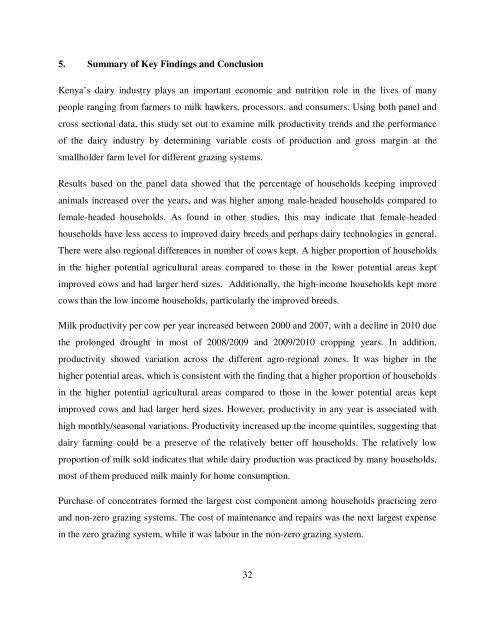WP43-Productivity-Trends-and-Performance-of-Dairy-Farming-in-Kenya
WP43-Productivity-Trends-and-Performance-of-Dairy-Farming-in-Kenya
WP43-Productivity-Trends-and-Performance-of-Dairy-Farming-in-Kenya
Create successful ePaper yourself
Turn your PDF publications into a flip-book with our unique Google optimized e-Paper software.
5. Summary <strong>of</strong> Key F<strong>in</strong>d<strong>in</strong>gs <strong>and</strong> Conclusion<br />
<strong>Kenya</strong>’s dairy <strong>in</strong>dustry plays an important economic <strong>and</strong> nutrition role <strong>in</strong> the lives <strong>of</strong> many<br />
people rang<strong>in</strong>g from farmers to milk hawkers, processors, <strong>and</strong> consumers. Us<strong>in</strong>g both panel <strong>and</strong><br />
cross sectional data, this study set out to exam<strong>in</strong>e milk productivity trends <strong>and</strong> the performance<br />
<strong>of</strong> the dairy <strong>in</strong>dustry by determ<strong>in</strong><strong>in</strong>g variable costs <strong>of</strong> production <strong>and</strong> gross marg<strong>in</strong> at the<br />
smallholder farm level for different graz<strong>in</strong>g systems.<br />
Results based on the panel data showed that the percentage <strong>of</strong> households keep<strong>in</strong>g improved<br />
animals <strong>in</strong>creased over the years, <strong>and</strong> was higher among male-headed households compared to<br />
female-headed households. As found <strong>in</strong> other studies, this may <strong>in</strong>dicate that female-headed<br />
households have less access to improved dairy breeds <strong>and</strong> perhaps dairy technologies <strong>in</strong> general.<br />
There were also regional differences <strong>in</strong> number <strong>of</strong> cows kept. A higher proportion <strong>of</strong> households<br />
<strong>in</strong> the higher potential agricultural areas compared to those <strong>in</strong> the lower potential areas kept<br />
improved cows <strong>and</strong> had larger herd sizes. Additionally, the high-<strong>in</strong>come households kept more<br />
cows than the low <strong>in</strong>come households, particularly the improved breeds.<br />
Milk productivity per cow per year <strong>in</strong>creased between 2000 <strong>and</strong> 2007, with a decl<strong>in</strong>e <strong>in</strong> 2010 due<br />
the prolonged drought <strong>in</strong> most <strong>of</strong> 2008/2009 <strong>and</strong> 2009/2010 cropp<strong>in</strong>g years. In addition,<br />
productivity showed variation across the different agro-regional zones. It was higher <strong>in</strong> the<br />
higher potential areas, which is consistent with the f<strong>in</strong>d<strong>in</strong>g that a higher proportion <strong>of</strong> households<br />
<strong>in</strong> the higher potential agricultural areas compared to those <strong>in</strong> the lower potential areas kept<br />
improved cows <strong>and</strong> had larger herd sizes. However, productivity <strong>in</strong> any year is associated with<br />
high monthly/seasonal variations. <strong>Productivity</strong> <strong>in</strong>creased up the <strong>in</strong>come qu<strong>in</strong>tiles, suggest<strong>in</strong>g that<br />
dairy farm<strong>in</strong>g could be a preserve <strong>of</strong> the relatively better <strong>of</strong>f households. The relatively low<br />
proportion <strong>of</strong> milk sold <strong>in</strong>dicates that while dairy production was practiced by many households,<br />
most <strong>of</strong> them produced milk ma<strong>in</strong>ly for home consumption.<br />
Purchase <strong>of</strong> concentrates formed the largest cost component among households practic<strong>in</strong>g zero<br />
<strong>and</strong> non-zero graz<strong>in</strong>g systems. The cost <strong>of</strong> ma<strong>in</strong>tenance <strong>and</strong> repairs was the next largest expense<br />
<strong>in</strong> the zero graz<strong>in</strong>g system, while it was labour <strong>in</strong> the non-zero graz<strong>in</strong>g system.<br />
32


